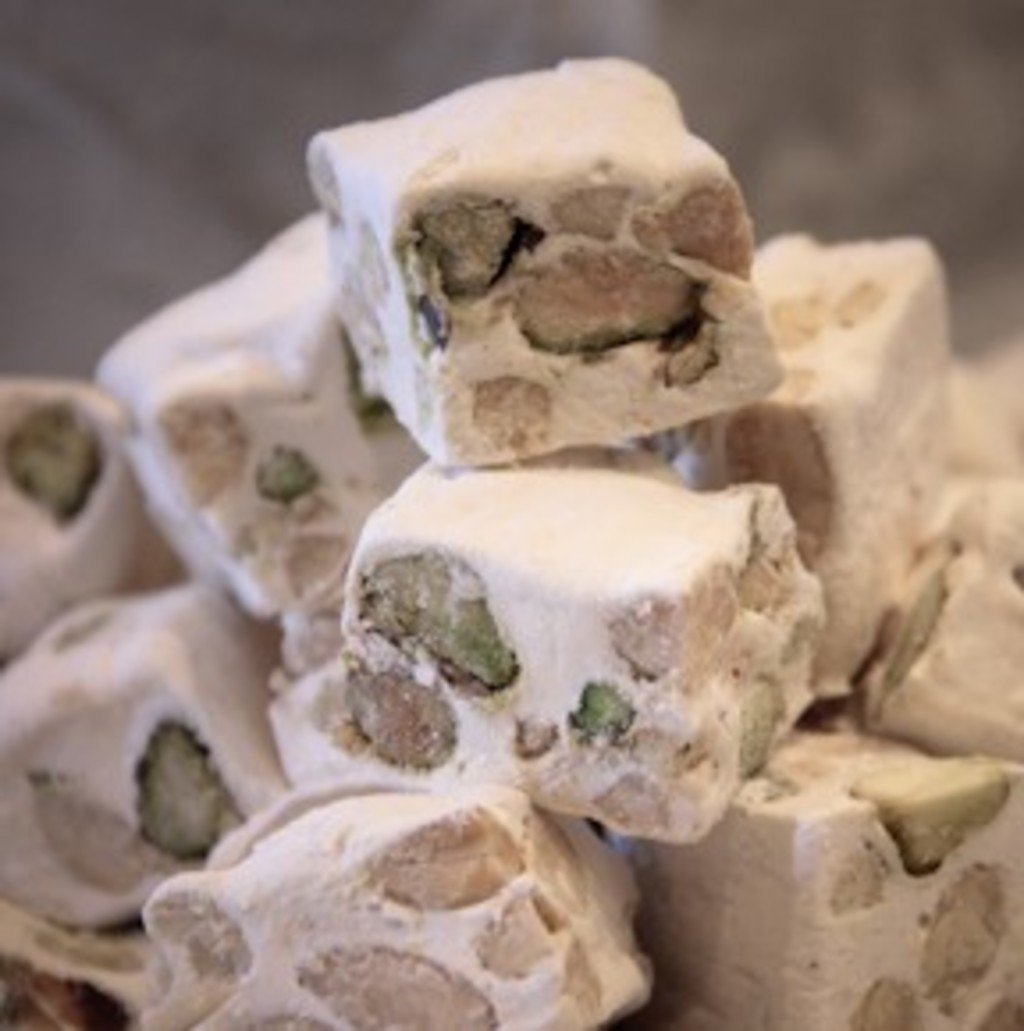Many of my best childhood memories were made in a small kitchen in Ohio, surrounded by my family at the oval-shaped country-kitchen table, making candy at Christmas.
We would make fudge or ‘white divinity fudge’, which is egg whites cooked with sugar. Mom would boil the sugar (dangerous stuff), Sis would help, Joe and I would kinda stand around and ‘look’ helpful, and then Dad would come in and do anything requiring muscle. (Muscle is essential when making candy.)
At culinary school, we made a traditional French Christmas candy, similar to Divinity, called Nougat de Montelimar – a pure white chewy nougat made with lavender honey, sugar, bright green pistachios and toasted almonds. Both recipes require cooking egg whites with hot sugar. The main difference is that nougat is made with honey and sugar cooked to the hard crack stage and formed into a block while Divinity is cooked to a soft ball stage and dropped from a spoon.
“Nougat de Montelimar” is technically the name for the candy that is made in Montelimar, France, and is a traditional Christmas sweet. There are strict guidelines for making Nougat de Montelimar – for a brief history lesson, visit the French confiseur, Arnaud Soubeyran for more details. Or, take a virtual trip to Montelimar via YouTube:
We can make nougat in the “Montelimar” style, though. All we need are whipped egg whites, a lot of cooked honey and sugar, pistachios and blanched, toasted almonds. You can make your nougat your own by adding candied lemon zest, vanilla, and dried fruits. Avoid dried fruits crusted with sugar, though, as those sugar crystals may convert your creamy nougat into gritty nougat.
The trick to success is cooking the sugar properly. Because of Denver’s altitude, we can’t rely on a candy thermometer’s reading for success. The first batch I made seemed to turn out perfectly until a day later when my ‘squares’ of nougat turned into little pillows.
Water typically boils at 212ºF, but not in Denver. At my home, it boiled at 200ºF. Sadly for me, I didn’t conduct that test until after I made my first batch of candy. The cost was my time and another trip to the store for more nuts so I could try again.
It’s easy to test your sugar using a thermometer as a guide. Use a clean metal spoon to drop cooked sugar in a bowl of ice water to confirm whether it is at ‘soft ball’ or the ‘hard crack’ stages as called for the in recipe. At ‘soft ball’, the sugar will come together in a malleable ball while in the ice water. At ‘hard crack’, the sugar will need to be peeled off the test spoon and will definitely crack.
This video demonstrates how to test the sugar but it doesn’t give you the recipe:
Most nougat recipes call for rice paper (or wafer paper). It’s hard to find, and it isn’t necessary. Substitute rice paper for powdered sugar, and you’ll have more fun in the process. Children can finger “ski” the powdered kitchen alps.
 The most difficult part of making nougat is the muscle that is needed in cutting the finished candy into individual squares. In Montelimar, they use power saws. Not quite sure how I’m supposed to do that at home, though. I could have used a strong, let’s say…. 6’2”, 210 lb. muscular boyfriend to cut through that dense candy. But, alas, it was just me; so I used the only power tool I have – girl power – and my sharpest chef’s knife. I have a tender spot on my palm, now, from pushing the knife through; but the divine sweet candy is worth a little pain.
The most difficult part of making nougat is the muscle that is needed in cutting the finished candy into individual squares. In Montelimar, they use power saws. Not quite sure how I’m supposed to do that at home, though. I could have used a strong, let’s say…. 6’2”, 210 lb. muscular boyfriend to cut through that dense candy. But, alas, it was just me; so I used the only power tool I have – girl power – and my sharpest chef’s knife. I have a tender spot on my palm, now, from pushing the knife through; but the divine sweet candy is worth a little pain.
FOR THE RECIPE, GO TO NOUGAT (DE MONTELIMAR STYLE) at www.thepatricianpalette.com.
 Patricia Bainter is a blogger and writer for 303magazine. She trained at Le Cordon Bleu London and shares her culinary musings and recipes at her own website ThePatricianPalette.com. Photos by Patricia Bainter.
Patricia Bainter is a blogger and writer for 303magazine. She trained at Le Cordon Bleu London and shares her culinary musings and recipes at her own website ThePatricianPalette.com. Photos by Patricia Bainter.






